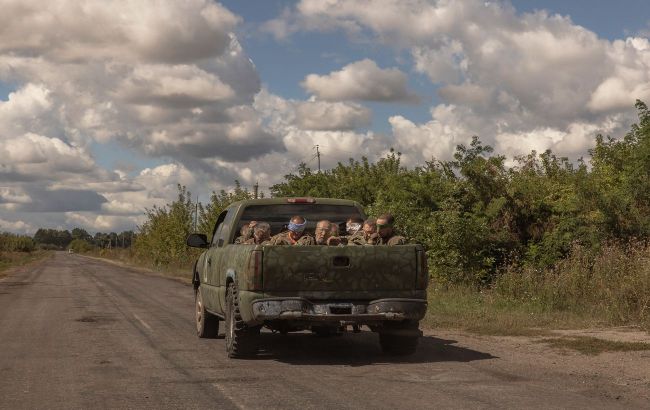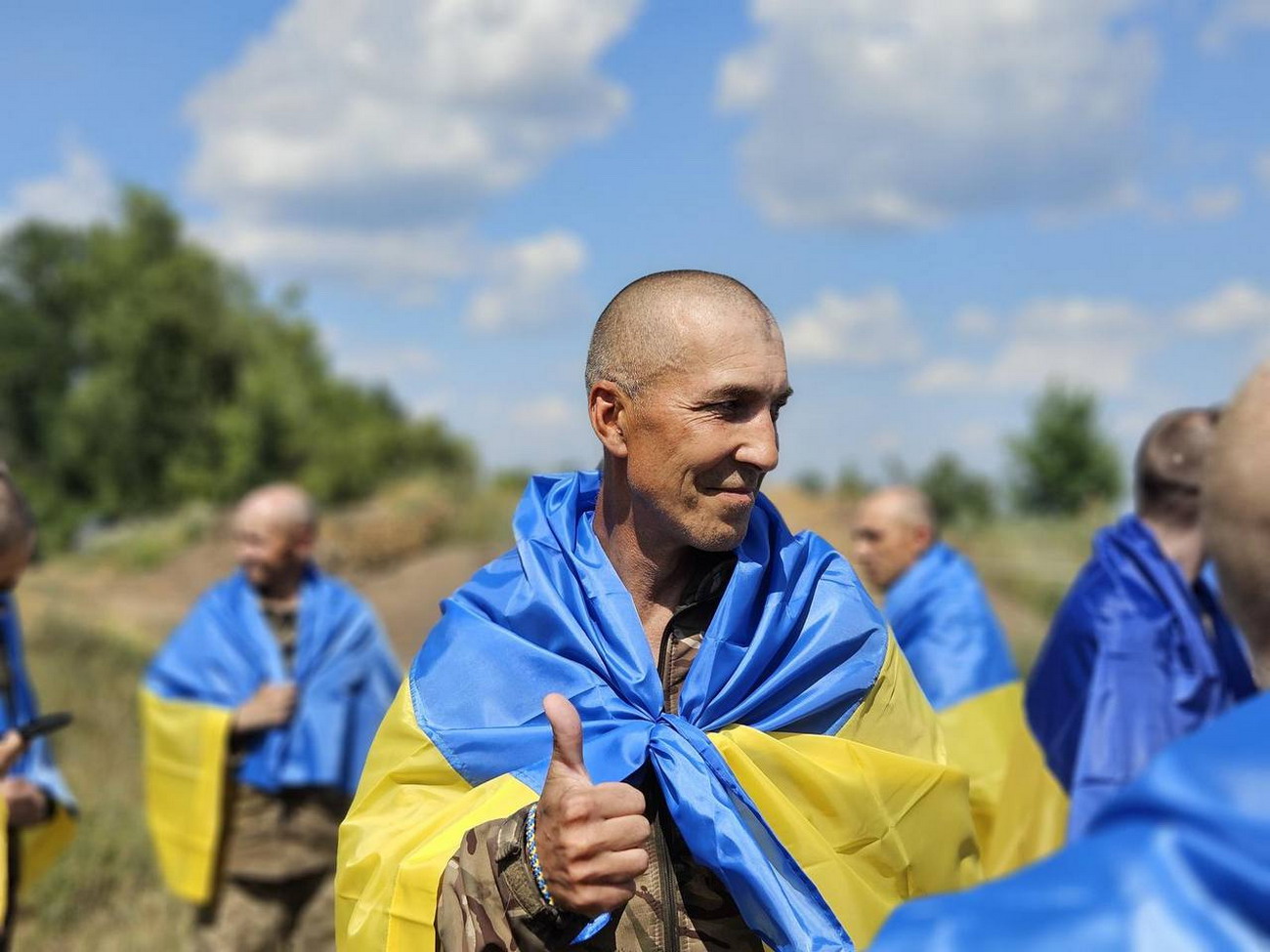Kursk offensive could push Russia to speed up prisoners-of-war exchanges
 Photo: captured Russian soldiers in the Kursk region (Getty Images)
Photo: captured Russian soldiers in the Kursk region (Getty Images)
During the full-scale war, Ukraine and Russia conducted more than 50 prisoner-of-war exchanges. This year, they stopped and started again, but the offensive on the Kursk region has raised hopes that the process will be revitalized.
RBC-Ukraine's article describes how the exchanges went and whether the Kursk breakthrough will speed up the return of thousands of Ukrainians.
Contents
- How exchanges have been conducted since beginning of year
- How and with whom Ukraine currently replenishing exchange fund
- Will events in the Kursk region speed up prisoner exchanges?
How exchanges have gone since beginning of year
The year 2024 began with the largest exchange of prisoners. On January 3, Ukraine returned 230 soldiers, including the defenders of Mariupol, Azovstal, Zmiinyi Island, and the Chornobyl nuclear power plant.
The next exchange took place on January 31. 207 soldiers of the Ukrainian Armed Forces, National Guard, border guards, and police returned home. Among them, about 40 people were injured or seriously ill. On February 8, another 100 servicemen were released.
Then the exchanges stopped for almost four months. During this time, Russian ombudsman Tatyana Moskalkova traditionally accused Ukraine of far-fetched demands and in May said that she had allegedly sent a list of 500 people. In response, the Verkhovna Rada Commissioner for Human Rights, Dmytro Lubynets, spoke of a difficult situation.
“Russia is blocking this process and refuses to approve the lists that we provide to the Russian side for exchange,” he wrote on his Telegram channel.
However, by the end of May, the process moved forward, and Ukraine returned 4 civilians and more than 70 military personnel.
 Photo: Ukrainians released during one of the exchanges (t.me/V_Zelenskiy_official)
Photo: Ukrainians released during one of the exchanges (t.me/V_Zelenskiy_official)
In early June, Vladimir Putin claimed that 6,445 Ukrainians were in captivity, while there were allegedly 1,348 Russians in Ukraine. These figures do not look fantastic, but they are still far from reality. According to the Ukrainian Coordination Center, as of January, more than 8,000 people (military and civilians) were held in Russian captivity. According to Lubinets, Moscow holds more than 14,000 Ukrainian citizens.
There is no official information on the number of Russians in Ukrainian captivity. However, it is known that a third camp for prisoners of war has recently been opened and preparations for a fourth have begun.
The next exchange took place on June 25, when Ukraine returned 90 soldiers who had defended Azovstal in Mariupol, the Chornobyl nuclear power plant and fought in the Kherson, Donetsk, Kharkiv, Zaporizhzhia, and Luhansk regions. Three days later, the deputy head of the Mejlis of the Crimean Tatar people, Nariman Dzhelal, two priests, and 7 civilians were released.
In July, a large exchange of female prisoners of war was announced, but on July 17, 95 male soldiers were released with the mediation of the UAE. This was the last exchange to date. Two weeks ago, Lubinets said he had finally started receiving information from the Russian side. He expressed hope that these steps would eventually lead to the Red Cross being allowed to visit the places where the prisoners are being held and called the Emirates a key partner and mediator. “We are very grateful to them. Our last returns were mediated by the diplomats of this country,” the ombudsman added.
How and with whom Ukraine currently replenishing exchange fund
In August, with the offensive of the Armed Forces in the Kursk region, the exchange fund began to be actively replenished. Literally on the first day, a video of the surrender of at least six Russians appeared. It was reported that this happened on the outskirts of the town of Sudzha, 10 km from the border.
Against the backdrop of the Kursk operation, on August 9, President Volodymyr Zelenskyy thanked the soldiers for three particularly productive days. “I want to thank those of our soldiers and our units who ensure the replenishment of the exchange fund - they take the occupier prisoner and thus help to free our people from Russian captivity,” he said.
Since then, videos with captured Russians have been increasing in number. One of them features the so-called Kadyrovites from Grozny (Chechnya). According to the I Want Lo Live project, they are of particular value because the Russian side demands them in the first place. According to Ukrainian fighters, more than 1,000 people were taken prisoner in the Kursk region during the first week.
The day before, footage emerged of an entire company surrendering on August 14. More than a hundred fighters left behind by their commanders made the right decision, according to the I Want To Live project.
Sources in the special services told RBC-Ukraine that soldiers from the Security Service of Ukraine's Special Operations Center captured 102 soldiers from the 488th Guards Motorized Rifle Regiment and the Chechen unit Akhmat. This is the largest massive capture that has ever been carried out in one go. Moreover, Russian troops were not going to surrender, and there was more than enough food and ammunition in the stronghold.
There are also reports of captured conscripts. Journalists from the Russian Vazhnye Istorii and Agency publications identified at least 22 people who had lost contact with them in the first days of the offensive. All of them served in the aforementioned 488th regiment and were conscripts from Kostroma, Vologda, Tyumen regions, the Komi Republic, and other regions.
According to The Independent, citing an unnamed Ukrainian colonel, about 2,000 Russians have been captured in almost two weeks. The agency notes that this is not accurate data, but numerous photos and videos show a large number of prisoners. Oleksandr Kovalenko, a military and political observer of the Information Resistance group, generally agrees with the assessment but suggests that the figure could be higher.
“They (The Independent - ed.) were a little late with their information. The number of captured Russians is now almost 2,500,” he told RBC-Ukraine.
According to The Independent, replenishing the exchange fund could have been one of the goals of the Kursk operation. Among other things, because there are no strong fortifications and Russian groups there as in other parts of the frontline. The large number of prisoners was a side effect of the rapid advance.
According to Kovalenko, the Ukrainian command realized that there would be a lot of prisoners. However given the fact that the Ukrainian Defense Forces faced the problem of their timely removal from the combat zone, no one was likely to count on such an outcome. At the same time, of course, such a large-scale operation could not have been launched solely for the sake of the exchange fund.
“A large number of forces and means are involved, and we are also suffering losses. And our military is being captured, much less than the Russians, in a sense, hundreds of times less. Setting the task of taking as many prisoners as possible is a very risky mission. If something goes wrong, the operation will fail. No one expected them to surrender en masse,” he said.
Currently, in the Kursk region, you can see what the Russian army is like, the expert believes. In this case, conscripts do not care about the Kursk region.
“It's not that they hate Vladimir Putin or anything like that. They don't care about Kursk, about Sudzha, conscripts are not going to die for all this. They do not want to fight, so they are surrendering en masse,” the source added.
Will events in Kursk region speed up prisoner exchanges?
Negotiations between the Russian and Ukrainian ombudsmen have intensified this week. According to Dmytro Lubinets, they were initiated by Moskalkova, but he cannot disclose details. He emphasized, however, that reports of captured conscripts and Kadyrovites allow us to be optimistic about future exchanges.
The other day, Volodymyr Zelenskyy said that it was important for Ukraine to return all our people. And yesterday, the strategy for the return of prisoners was presented to the Supreme Commander-in-Chief's Staff meeting.
“There are many delicate details. It concerns the formation of lists. It concerns the work with partners,” the President said and instructed the military to explain how the exchange procedure will be carried out.
In particular, Ukraine will expand the negotiation group. It will include six more agencies: representatives of the Security Service of Ukraine, military and foreign intelligence, the Ministry of Internal Affairs, the Armed Forces of Ukraine, and the Ombudsman. According to Security Service of Ukraine Head Vasyl Maliuk, the group will focus on preparing the exchange of military and civilians, including those held by Russia since 2014.
According to the Chief of the Defense Intelligence of Ukraine Kyrylo Budanov, the priority is to return the seriously wounded and sick, women and all those who have been held captive for a long time. Special attention will be paid to the defenders of Azovstal.
Oleksandr Kovalenko is confident that the successes in the Kursk region will speed up the release of thousands of Ukrainian citizens.
“The result is a large number of prisoners, primarily conscripts. And this makes Russia react. If earlier they took the position that they would not negotiate, now, as we can see, their position has changed very quickly,” he noted.
According to him, the position has changed because behind every conscript is a family that receives neither hundreds of thousands of rubles in salary nor one-time payments. And this factor can destabilize the situation in Russia.
“And Putin doesn't need anything to destabilize the situation, or for anyone to take to the streets with protests. That's why they will be engaged in prisoner exchanges and quickly,” the expert summarized.
Today, Dmytro Lubynets noted that the exchange of prisoners in the “all for all” format will not take place soon. He also confirmed that the Kursk operation is improving the situation with the return of Ukrainians. In this process, he said, the Ukrainian side wants to agree with Moscow on the principles of exchanges.
“We need to use the principle of justice. Those who were captured earlier get out. We have lists of prisoners of war and civilian hostages taken by the Russians before the full-scale invasion began in 2014, and we have defenders of Mariupol who have been in captivity for more than two years,” he added, without specifying whether the Russian side had provided lists of people in whom it was primarily interested.
Sources: statements by Ombudsman Dmytro Lubynets, President Volodymyr Zelenskyy, information from Telegram channels, RBC-Ukraine's sources in the Security Service of Ukraine, The Independent, and comments by military expert Oleksandr Kovalenko.

